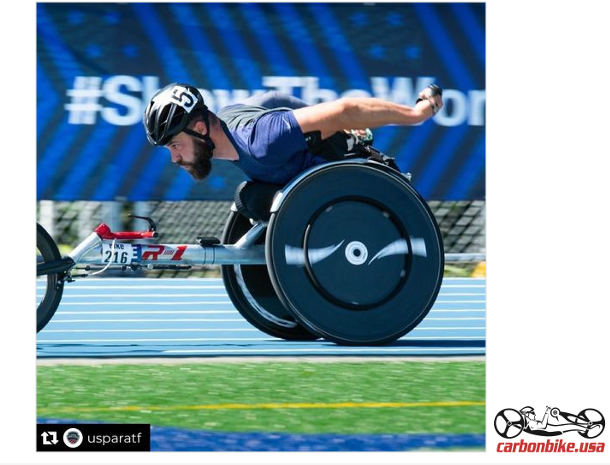https://store-udr610a2x4.mybigcommerce.com/manage/page-builder?channelId=1576766
Carbonbike-USA R-1 Racing Wheelchair
Step-by-Step Measurement Guide
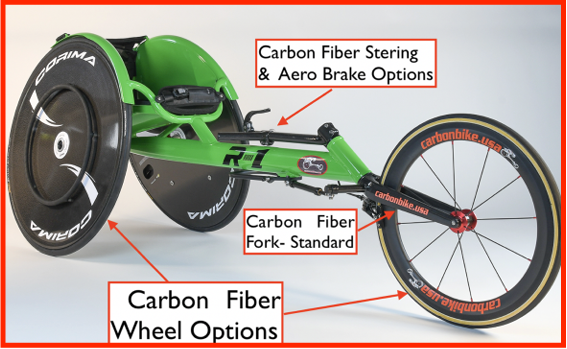
Carbonbike-USA
R-1 Features
• Custom 6061 T6 Aluminum OPTIONAL WHEELS
Top and Sub-Frame • Wheels
– Fenders & full side panels – Front: 20”
– Ovalized tubing • Tubular tire
– Choice of U Cage or Open • Aluminum or Carbon
V Design – Rear: 700C
• Carbon fiber Fork • Tubular tires
• Carbon fiber Steering • Aluminum or Corima
• Fabric sling/welded inserts for Carbon fiber 4 spoke/disk
knee ratchet straps • Pushrims
• Brake – Tire coated standard
• Flag holder
• Fixed axle
Step 1
Athlete & chair information
Before you begin: Measurement of existing
• Height, weight chair to include:
• Classification (How-to in next slides)
• Injury and onset • Upper frame
• Experience level • Lower frame
• Type of racing: • Overall length
track or road • Rear seat height
• Has existing chair • Front knee or seat
• Axle postion
Measurement Considerations
Type of injury:
• Spinal Cord Injury, lower limb loss or condition affecting the lower body
– Trunk balance: how much does athlete have?
• Affects Axle position
– Trunk length affects:
• Seat heights
– Transfers influence:
• Cage style
• Footplate needs
• Experience level
– Cage design
– Axle position
– Chair length
• Type of racing: track or road or both
• Camber
– Chair length
– Affects front fender width
• Knee width
– Cage style
Determine best cage design:
U Cage vs. Open V Seat Design
Open V
• Recommended for new users
• Traditional or Kneel position Upholstery
• Athlete has limited balance. (T-10 & above)
• Needs more “squeeze” or bucket
U Cage
• Best for elite or advanced users
• Kneel only or Amputee Upholstery
• Athlete has good trunk balance.
• (SCI T-10 and below)
• Position is more flat
U Cage Style
• U- cage: preferred by elite athletes
• Not recommended for beginners
• Requires additional measurements
– Knee height from floor
• Error on low side
– Knee width critical
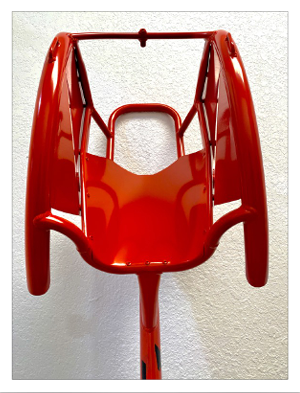
Open V Cage Style
• Open V- offers stiffness and wider opening for big/thick legs
• Best for new athletes
• Easier transfer

How to Measure: Racing Wheelchair Step-by-Step Guide
• Demo or using existing chair is key
• Guide for measurements without a chair is at the end of this document
• Measure the demo chair before the customer gets into it and document this on the order form (see diagram on right)
A. Upper frame width: directly above the axle, inside panels
B. Lower frame width: rear
C. Knee width
D. Axle position (next slide)
E. Rear/front seat height or angle

How to Measure Continued
A. Axle position: center of axle to front of vertical rear tube
B. Knee height: Floor to top of seat rail
C. Rear seat height: Floor to top of rear seat
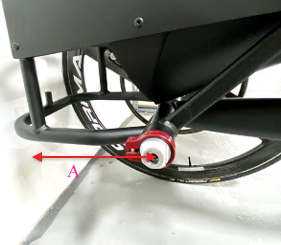


Completing the Order Form
• Decide Cage style: complete page 2 or 3 of order form
• Athlete should position themselves in the chair
• How does the athlete fit?
• How much room on each side? Can use a hand or hard object like a book (add or subtract accordingly)
• Upper cage width: measure above axle
• Lower cage width: measured @ rear seat
• Camber: affects cornering and width of front fenders
• Axle position
– Typically 5-8”, 5-6” more stable for higher level injuries, 7” is most common, 8” low level injuries
– Climbing
– Hop around obstacles
– Fine adjustments w/ upholstery
• Over all length:
U-Cage specific measurements
See diagrams on next slide for more details
• Kneel height
– 15 or 20 degrees common for most SCI
– Legs lower would want less angle
(those with good balance: amputees/very low SCI, etc.
• Knee depth: (18” standard)
– Back of the hip to crease in knee
• Knee Width
• Rear of Backrest to Front of Crossbar
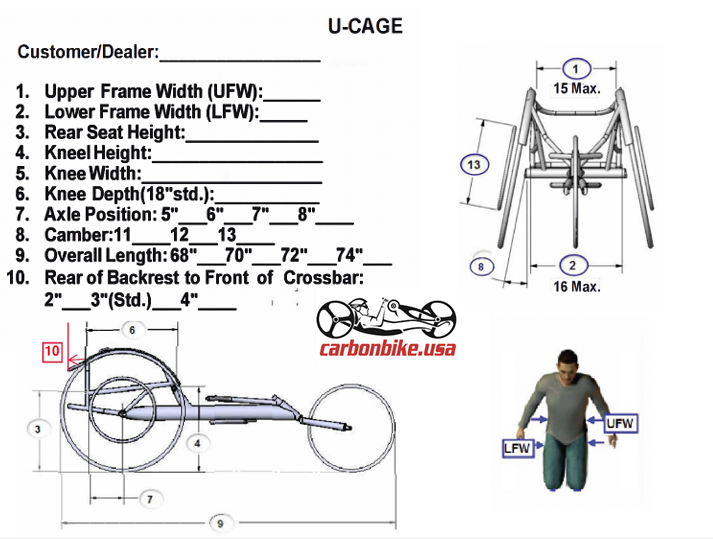
Open V Cage specific measurements
• V Depth-longer allows more room for transfers and legs
• Cage Depth
– knees lower would be longer (have more balance)
– Knees higher would be shorter (less balance, higher level injuries)
• Seat Heights (must be able to reach pushrim)
– 17” rear and 18” front minimum to use kneel uphol.
– Lower seat heights for higher level injuries
– Long trunk sit lower/short trunk sit higher

Options
• Welded Strap Hooks
• Extra insert for ratchet straps
• Aluminum welded back
• Aluminum solid seat
• 3” cut out axle
• Aero Brake lever
Wheels:
not included in price
• Use your existing wheels or add:
• 20” aluminum spoked front wheel
• 20” Carbon fiber rim front wheel
• 700C aluminum spoked rear wheels
• 700C Corima Carbon fiber 4 spoke
• 700C Corima Disk wheels
Note: Price of rear wheels included tire coated push rims. If purchasing wheels need to choose push rim size
How to measure new athletes without an existing Racing Wheelchair or demo chair
• Position athlete sitting on a chair or in their everyday chair
• Take 2 flat hard objects such as a book
• Upper Frame Width (UFW): place a book on each side of athlete as shown in diagram on right (about 2” above navel)
• Using a metal tape measure take the measurement between the books and record
• Lower Frame Width (LFW): repeat same procedure as UFW to measure the outside of the hips pressing in slightly to get an accurate measurement
• Knee Width: (U cage only) Position the knees together and measure across the knees, do not press too tightly, it is better have more room to avoid excess pressure

Guidelines for Open V cage measurements without an existing racing wheelchair
• V depth:
• 25” recommended for most persons
• 26” recommended for persons with longer or thicker legs
• Cage Depth: 15” recommended
• Axle position: 7” is the most common
• 5” for athletes with very limited trunk balance or lower amputees
• 6” for athletes with limited trunk balance
• 7” for athletes with good trunk balance
• 8” not recommended for new athletes
• Rear seat height: 16”
• Front seat height: 17”
• Camber: 12 degrees recommended
• Overall length: determined by athlete competition venues: track or road
• 72” is best for most athletes but shorter recommended for shorter athletes or those only racing on the track and a bit longer for taller athletes
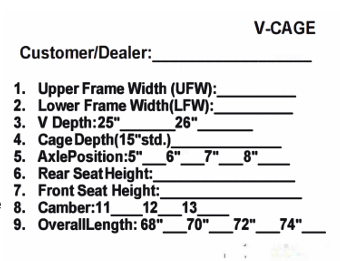
Getting it right = RESULTS!
We can help, just give us a call.
